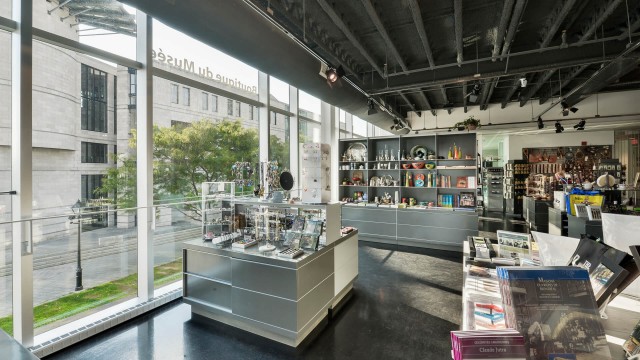November 2017
Discovering Québec differently - EAU – Dans le sillage du temps
EAU – Dans le sillage du temps is the third publication in a prestigious series on archaeology in Quebec
Montréal, November 13, 2017 — Pointe-à-Callière, Montréal Archaeology and History Complex and the ministère de la Culture et des Communications (MCC) are pleased to announce the publication of Eau – Dans le sillage du temps, the third title in a series of five books in the Archéologie du Québec collection. This book, which offers a different perspective on Québec, and the entire series, emerged out of the two organizations’ desire to provide an overarching, illustrated, and thorough overview of some 50 years of archaeological research in Québec.
“It’s not so surprising to see how water affected Québec’s development. What is unexpected is to see how archaeology reveals previously unexplored facets of it. And even more fascinating, despite the wealth of these discoveries, we know that archaeologists have explored only one percent of the territory. So many questions remain. But this work answers many questions while at the same time emphasizing the importance of preserving this heritage and continuing to conduct research to further our knowledge,” notes Francine Lelièvre, executive director of Pointe-à-Callière.
A new look
The book Eau – Dans le sillage du temps broaches topics that offer a new look at how humans explored natural environments, adapted to them, and benefited from their resources. Whether using them for travel, trade, hydraulic power, drinking and washing, or developing cities, people from all eras formed a close and vital relationship with the St. Lawrence and the thousands of rivers and lakes in Québec.
Famous wrecks
In particular, the book offers new perspectives on Québec’s underwater and maritime heritage. It covers numerous underwater sites and some of the wrecks that bring to mind important moments in our history, such as the last battle of Machalut in the Gaspé, the sinking of the Elisabeth and Mary on the Côte-Nord, or the drama of the Empress of Ireland near Rimouski. But for those interested in the connection that people have had with water since the dawn of time, this archaeological heritage, while spectacular, is far from the only topic covered in the book. The authors also explore significant milestones in the history of sailing on the St. Lawrence and various types of vessel, from prehistory to present.
Water, vector of economic development
Readers will learn about the arrival of the first Basque hunters in the St. Lawrence estuary, the building of cod-fishing camps in the Gaspé, and the construction of forts and trading posts in central and northern Québec. The book talks about how cities transformed as they became illuminated by electricity, cities like Shawinigan and Chicoutimi, which became industrial powerhouses thanks to hydro power. It also describes how new port facilities in large cities like Quebec City and Montréal contributed to the province’s economic development, and how water and sewer networks transformed people’s daily lives starting in the early 19th century.
A seasoned team
The task of writing this 216-page, generously illustrated, work was given to two experienced archaeologists, Michel Plourde and Daniel LaRoche, assisted by a team made up of archaeologists Christian Roy, 30-odd other contributors, an editorial committee, and a science committee. The book was produced under the direction of Pointe-à-Callière’s archaeologist in chief and conservator Louise Pothier, project manager Sophie Limoges, and editing contributor Annick Poussart. Les Éditions de l’Homme have been involved in the production and distribution of all the books in the Archéologie du Québec series.
A national series
To produce the series, a partnership was formed between the MCC and Pointe-à-Callière. Among the series’ five books, four will cover archaeological discoveries, organized according to the four elements Air, Water (already published), Earth, and Fire (coming in 2019). Published in 2016, Fragments d’humanité – Pièces de collections rounds out the series. It presents Québec’s many artifact collections, in particular those held by the government.
EAU – Dans le sillage du temps, published by Éditions de l’Homme, is available for $34.95 at the Museum shop and in bookstores. The book can also be ordered online from the Pointe-à-Callière website at pacmuseum.qc.ca.
About Pointe-à-Callière
Rising above the birthplace of Montréal, Pointe-à-Callière is the city’s largest history museum. It is a complex comprised of a series of historic and archaeological sites of national significance that showcase major periods in the history of Montréal, from 1350 to the present day. The only large-scale archaeology museum in Québec and in all of Canada, Pointe-à-Callière opened in 1992 on the occasion of Montréal’s 350th birthday. The Museum’s mission is to raise awareness and foster an appreciation of the history of Quebec’s largest city, and to forge bonds with regional, national, and international networks concerned with archaeology, history, and urban issues. Its mandate consists of preserving and increasing access to Montréal’s heritage, which led to its creation of the Montréal Archaeology and History Complex, a world-class cultural and tourism complex that will showcase some ten historic and heritage sites in Old Montréal.
Pointe-à-Callière is subsidized by the City of Montréal.
-30-
Media: Marylène Kirouac, Communications Coordinator
[email protected] / T. 514 872-2687

